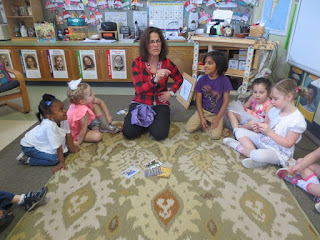“Poetry is the
spontaneous overflow of powerful feelings.” – William Wordsworth
Fourth grade recently spent time learning and practicing the
creative process of writing poetry. We
began straightforwardly with the introduction of list poems, and gradually
introduced more complicated techniques and styles such as Haiku, soul poems, origin
poems and poems inspired by artwork. Students brought open hearts and minds to
the process and the resulting poems reveal the student’s vulnerability and
developing maturity.
Recently retired AFS middle school English teacher Jane
McVeigh-Schultz visited our class as a special guest to demonstrate combining visual
art and writing. Presenting the class with artwork by Marc Chagall and others,
McVeigh-Schulz illustrated how to allow images in art to illicit thoughts and
feelings that, when recorded, create interesting poems.
Here is a small sampling of some of the wonderful poems that
fourth graders created:
My Soul
My soul is two dirty bare feet and crazy, unbrushed hair
My soul is an excuse to play with the hose
My soul is finding something fun to do in the summer besides
complaining about being baked
-Kaitlyn
The Dream
Oh Mama of mine I had the strangest dream last night
In the dream I flew away on a Pegasus horse
A veil like snow trailed behind me
The smell of flowers filled my body with happiness

But soon it died and the sound of pain and suffering filled
the air with violence.
Oh my dearest girl, what in the world made you think that
our world is filled with peace and joy?
That was only the first part, Mama
Then I saw myself in a snow-white dress
With a gold locket around my neck.
-Maura
I Sit, I Wait, I Think, I Stare
I sit, I wait, I think, I stare.
My tea is cold just standing there.
I sit, I wait, I think I stare.
The air is cold, too cold out there.
I sit, I wait, I think, I stare.
If only someone were sitting there.
I sit, I wait, I think I stare.
My tea is cold just sitting there.
-Matthias
The Escape
Escape, escape from the uneasy planet
never settled
always in war
We start the swim in
the murky water of our imagination
gods gazing upon
the galaxy
always being hit with
the cold hard action of leaving a place
but being wrapped in
the warm blanket of beginning in a new one.
I will miss the
little bubbles that you can pop with your finger
I will miss this old
place.
-Drew
While the poetry unit lasted just several weeks, the theme
of poetry has permeated our entire year. Each morning begins with a poem of the
day that students are invited to ponder and comment about. The poems created by
each student will be turned into small chapbooks for students to bring home and
refer back to as they grow.
###


































